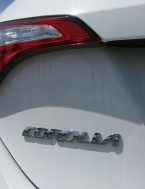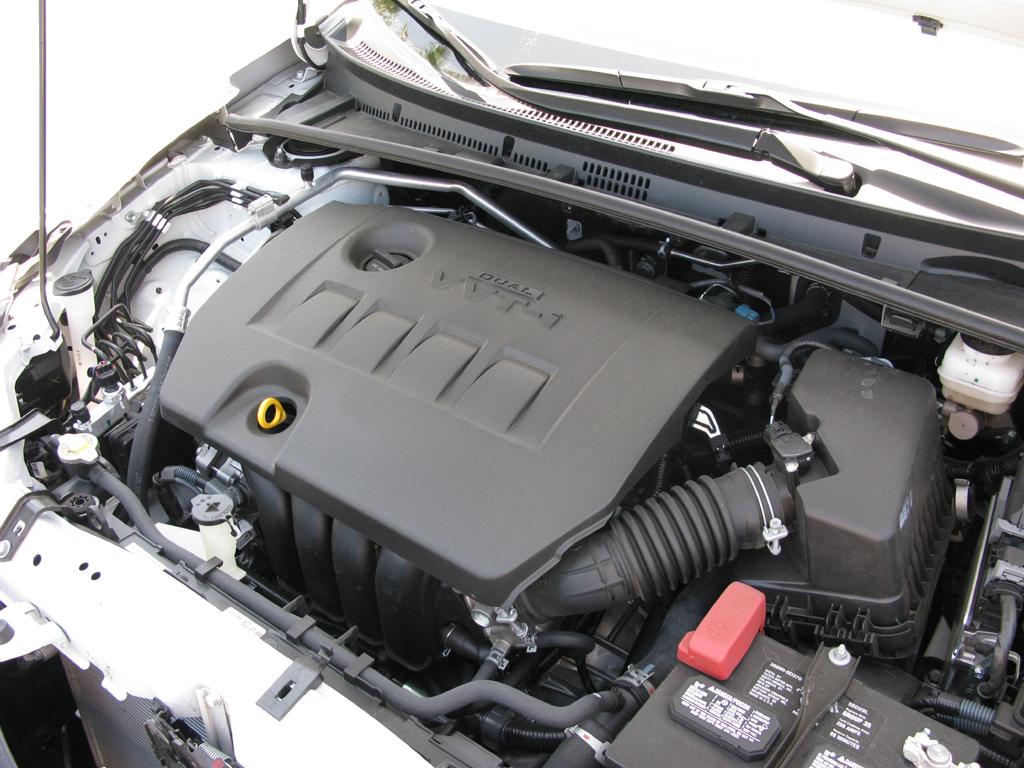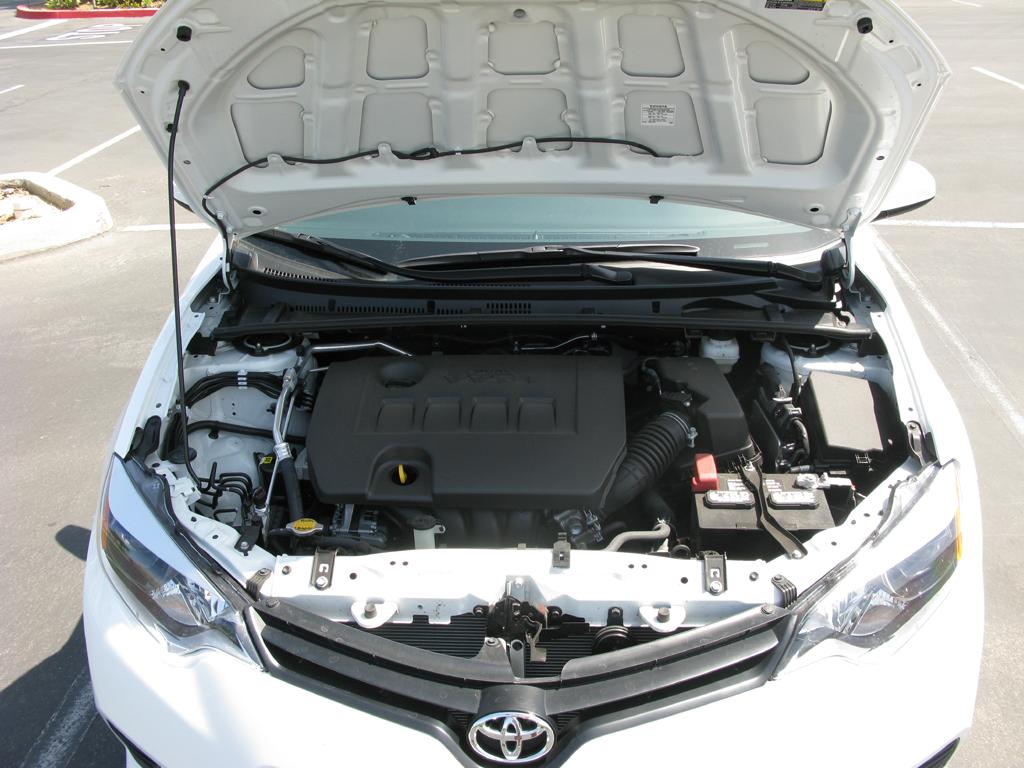
Review Index
2014 Toyota Corolla LE – Part 1 (Exterior)
2014 Toyota Corolla LE – Part 2 (Interior)
2014 Toyota Corolla LE – Part 3 (Interior – Electronic Features)
2014 Toyota Corolla LE – Part 4 (Powertrain)
2014 Toyota Corolla LE – Part 5 Chassis and Suspension)
At a glance, it gives you an impression that the whole Corolla family only offers one sole choice of a 1.8L 4-cylinder engine, for the US market. But please pay attention that there are actually two different engines, even though they both has 1.8L displacement.
The one on our LE trim test car is the Toyota 2ZR-FE engine, making 132hp at 6,000rpm and 128 lb-ft of torque at 4,400rpm; on the other hand, another engine – the 2ZR-FAE which is used on models with “Eco” as postfix after the LE trim name (i.e: LE Eco, LE Eco Plus, LE Eco Premium), are making 8 more horsepower than the 2ZR-FE, at a 100 higher rpm (140hp at 6,100 rpm), and reaches the peak torque of 126 lb-ft much earlier (at 4,000 rpm). Although the 2ZR-FAE engine makes more power, it is more efficient than the 2ZR-FE: the Corolla LE CVT’s rating is 29/38mpg (city/hwy), and the LE Eco CVT is rated at 30/42mpg (city/hwy).
The difference between the 2ZR-FE and 2ZR-FAE engine is not just the addintiona letter “A” in the code name. Compared to the 2ZR-FE which has Dual-VVTi to adjust timing on both the intake and exhaust camshafts, the 2ZR-FAE instead uses a more advanced valve technology called “Valvematic”.
The Valvematic system can not only adjust the timing on intake/exhaust valves, but also control the lift volume of the valves, which means it can control the intake’s fuel/air mix ratio, therefore the 2ZR-FAE does not need to have a conventional throttle body and the throttle plate. BMW also has a similar design like this (used on many current BMW turbo engines), and is called “Valvetronic”.
Because the Valvematic can control the volume of air entering the engine more precisely, the 2ZR-FAE engine achieved 10% gains in fuel efficiency and power output. This is the reason why the Corolla LE Eco trims has higher output, and at the same time has lower fuel consumption than the LE trims.
Besides the Valvematic feature, the 2ZR-FAE engine also has higher compression ratio of 10.5:1 (up from 2ZR-FE’s 10:1). Also, the redline is raised from 6,400rpm to 6,600rpm.
The 2ZR engines are relatively light weight, with service weight around 258 lbs. Because the Corolla is on a front-wheel-drive platform, its front need to be much heavier than the tail, therefore putting the 258lb engine in front of the front axle, helps to achieve the goal for the Corolla with 2,855lb curb weigt.
The high weight/power ratio of 21.6 lb/hp taxes Corolla LE’s acceleration performance. The 0-60 run is smooth and linear, but not strong. Obviously Toyota programs the engine ECU more toward to the conservative side. Under “normal” gas pedal operation, you can definitely feel that the engine is too lazy to use its full potential under the workload. To make the engine contribute 100% of its ability, you need to press the gas pedal nearly all the way down to the floor; then you can see the engine happy to rev up, and the acceleration strength meets the 132hp claim.
This is an overview of the engine bay, we can see the intake manifold of the 2ZR-FE engine is placed in front and the exhaust manifold is on the rear. The advantage of placing the intake in front is: intake air which enter the combustion chamber will has lower temperature, which boosts output horsepower.
There might be some people do not like Corolla’s throttle mapping, especially those who like low-end torque (for example, just slightly tap the pedal, then lots of torque comes out). But if we look at this on another side, this mapping style creates an unique experience for the driver: the higher the rpm goes, the stronger strength of acceleration he feels. This differs significantly than how some turbocharged engine, which usually has very strong strength at the initial accleration from standstill, but the strength fades away after the speed has climbed to a certain level and the engine rpm goes up.
Theoretically the CVT should be absolute smooth, but when you are driving the Corolla, you can feel the familiar shift jerk which is familiar in a car with traditional automatic transmission. Do not worry about this – it is not a mechanical malfunction or defect, because this is done by Toyota in purpose. Toyota engineers introduced this artificial shutter to imitate the feel of a traditional 8-speed automatic transmission. I guess this is because after market survey, Toyota believes more customers prefer the feel of traditional automatic transmission over the butter-smooth CVT.
The Corolla is capable of running up to E15 gasoline (gasoline that contains 15% ethanol by volume).
Summary to the powertrain: the Corolla has smooth and comfortable power delivery, in a leisure style. The engine and transmission meets your daily commute needs; merging into the highway traffic is not as easy as the 250hp+ sedans, but you can still do it without difficulty most of the time. One thing you should keep in mind: if you are in a hurry to arrive at your destination and want to drive fast, you need to tell Corolla by pressing the gas pedal deep most of the time when you need good acceleration.
For more detailed technical information of the Toyota 2ZR-FE engine, please download this official document for your reference.







Recent Comments